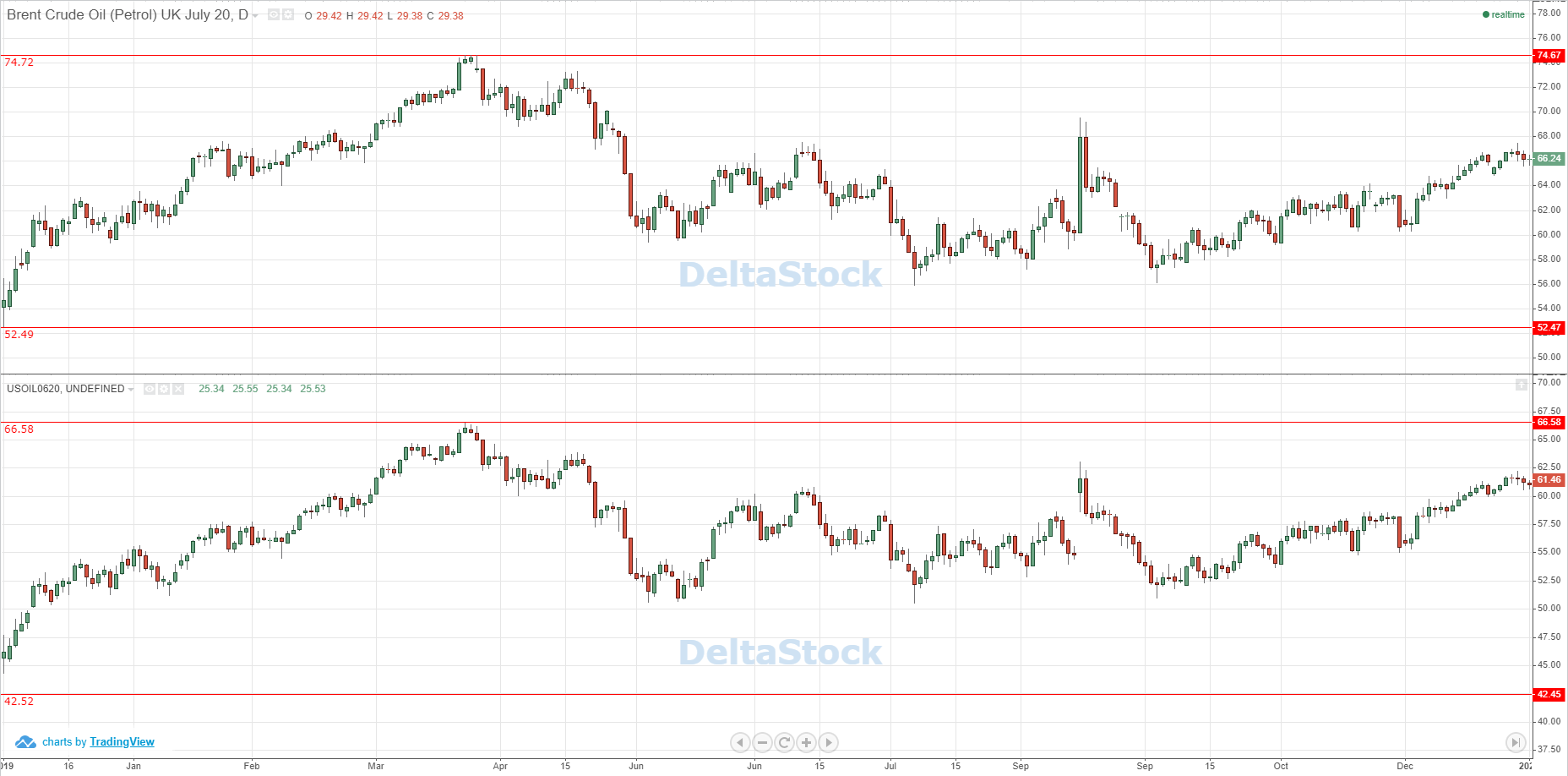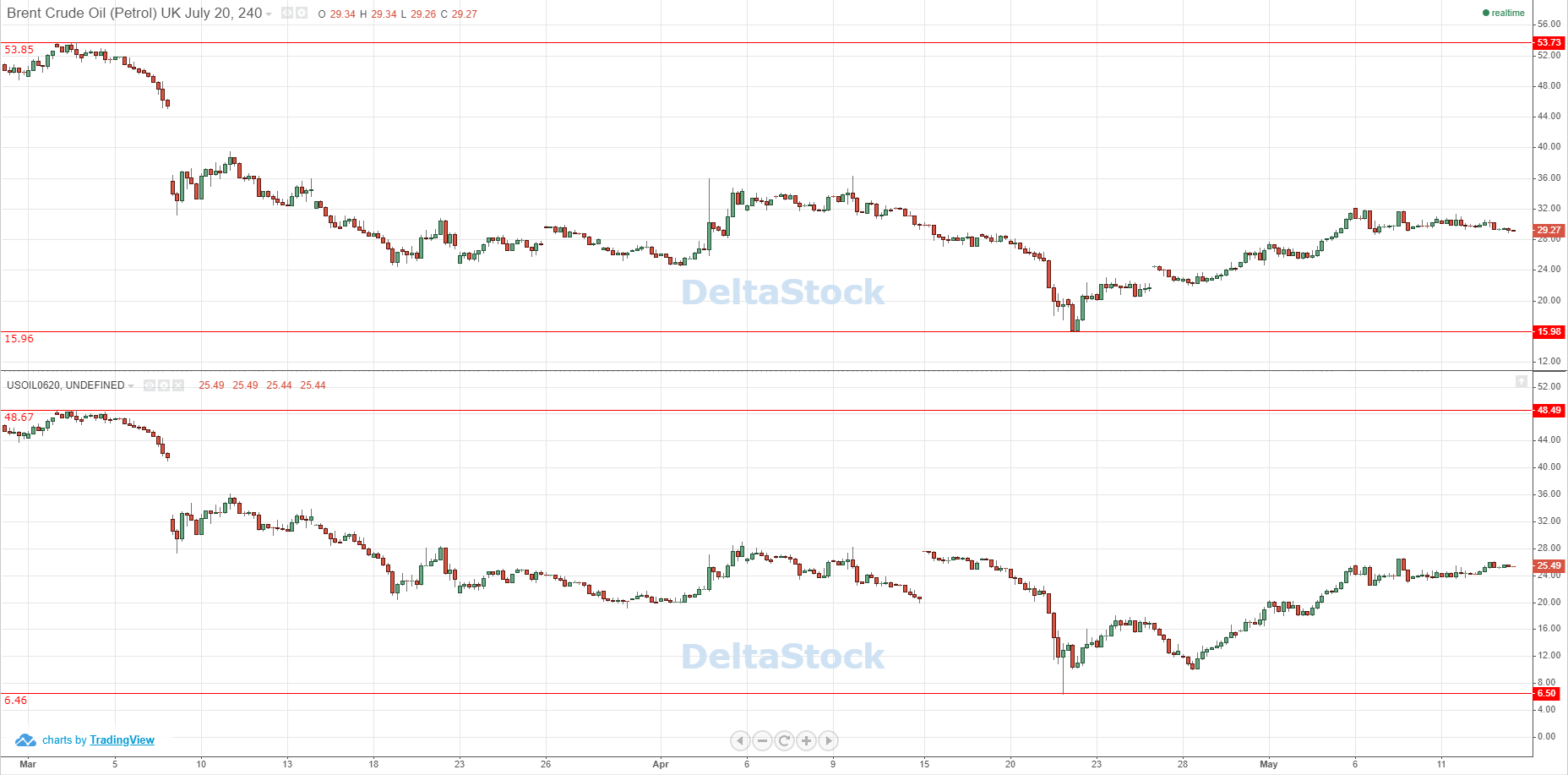
Source: Depositphotos.com | Author: DeltaStock
Reading time: 15 minutes
In the years following its discovery, oil quickly became known as the “black gold” due to the variety of investment opportunities that it offers to traders and investors from across the world. Because of this, it’s not at all surprising that, today, this commodity is of crucial importance not just for the energy sector, but for the global economical and political scene as well.
If you have always wondered what are the causes behind oil’s frequent peaks and troughs and how you can take advantage of them from the comfort of your home, this handbook is just the thing you need!
A few words before we begin
Oil trading is a complex endeavour and many beginner traders fail to effectively take advantage of oil’s price movements due to their ignorance regarding the idiosyncrasies of this sector.
In this article, we will take a look at:
– What is oil and some reasons why you should trade it
– Which factors influence oil’s price movements
– What are market sentiments and why it’s important to keep track of them
– What are the differences between the popular Brent and WTI oil types
– Why it’s important to study the history of the oil sector
– Types of oil instruments which you can trade online
– How and why you should open a free trading account
– Common trading styles and important principles
– What are some of the risks of trading oil
What is oil?

Source: Depositphotos.com | Author: DeltaStock
Oil is a type of fossil fuel that is extracted from the earth in the form of crude (unrefined) oil. This commodity is later refined and turned into useful products for the general public like fuel, plastic, compost, medicine and others.
Oil is not a widely available resource and is produced by 100 out of a total of 195 countries in the world. Thirteen of these countries, among which Iraq, Iran, and Saudi Arabia, are members of the intergovernmental organisation OPEC and are responsible for a whole 41% of the global yearly output.
With such concentration of power, it shouldn’t come as a surprise that thousands of traders and investors frequently monitor OPEC’s every move as even the slightest hint concerning the increase or decrease of the daily oil output could significantly influence the commodity’s market price. Of course, OPEC is far from the only big player in the sector. For instance, Mexico, Norway, and Russia are not members of OPEC and are responsible for another 14% of the black gold’s yearly output.
Why trade oil online?
As one of the most traded commodities in the world, oil is often the key ingredient in a wide array of financial strategies of varied scope. Here are some reasons why you might want to trade oil shares:
1. Dynamic market environment. Under normal conditions, oil supply and demand are interlocked in a delicate balance, which causes the commodity’s price to fluctuate, i.e. it’s never static. It’s this dynamic that traders take advantage of. Depending on the trading strategy in use, traders could either open a position on the market when the financial instrument’s price is increasing or when it’s decreasing.
2. Risk control tool. The black gold is often used to diversify (enrich) a trading portfolio, as well as a way to protect (hedge) another investment in case some of the other markets in the instrument portfolio turn against the trader.
3. Easy market access. Gone are the times when oil trading was reserved only for private investors. Today, everyone can invest money in the commodity from the comfort of their home via their desktop computer, tablet, or smartphone. The only thing you need to do is open an online trading account.
Now that we’ve defined what oil is and highlighted the advantages of trading the commodity on the markets, it’s time to explain how you can actually do that.
Find out what moves the oil market
The price of oil, like that of any other product, is influenced by the supply and demand on the market. For instance, the abundance of oil on the market would lead to a decrease in demand, and from there to a lower market price. The opposite is also true – the lower oil output would boost the demand and lead to a higher asking price.
Here, we would like to once more point out that the price of black gold is in constant flux. While the commodity’s price today typically ranges between $20 and $30 per barrel, there are also recorded cases of its price soaring to $135 per barrel, as well as instances where it has plummeted to negative values.

Price movements of Brent and WTI for 2019-2020 | Source: DeltaStock
The freshest example of this is the COVID-19 pandemic, which in May 2020 crushed the per barrel price of futures contracts to under $-37. There are a few reasons for this drastic decline, namely:
– The devastating effect of the coronavirus on the global economy, which has led to record low levels of demand for oil products.
– Some producers prefer to pay their buyers in order to dodge expenses, such as the purchase of additional storage spaces, as well as to avoid halting the production in case full storage capacity is reached. In this current situation, it’s tough to find any buyers for the products, which forces companies to bring oil prices to record lows.
– The oversupplied oil market makes the finding and purchasing of additional storage space an increasingly harder and expensive venture. For example, during April 2020 the oil storage facilities in the US reported the greatest volume of stored barrels since 1946.
– The aggressive price war led among the bigger oil producers, which overwhelmed the oil market and depleted the available barrel storage space.

Price movements of Brent and WTI for March-May 2020 | Source: DeltaStock
In addition to supply and demand, which are mainly determined by the volume of global oil output, the price of oil is also influenced by other important factors, such as:
– OPEC’s production policy and that of other big companies
– The number of subsidies that oil companies receive
– The monthly user demand for oil products
– The geopolitical environment in or close to the oil fields (treaties, military conflicts, natural disasters and so on)
– What competing companies in the renewable energy sector and other energy sectors are doing
Study the market sentiments
Oil markets and, more specifically, the energy futures markets are typically dominated by professional traders and institutions with tremendous amounts of capital. Usually, people with smaller budgets would only decide to invest in the commodity when there is a clear bullish (positive) market trend. This financial injection will often significantly strengthen the market momentum, which in turn would lead to historic peaks. Of course, when too many people decide to invest in the same asset, sooner or later markets register just as memorable troughs.
Identifying these and other typical market sentiments are of key importance for your success in this sector and on the financial markets as a whole since this knowledge could help you better gauge when a market position is profitable and when you would be better off waiting for the excitement on the markets to cool down.
Types of oil: Brent vs. WTI

Source: Depositphotos.com | Author: DeltaStock
Oil comes in many shapes and sizes, but its most popular benchmarks are the Brent and West Texas Intermediate (WTI) varieties. Both types differ in density and the amount of sulfur they contain, while since 2010 their previously close to even prices started drifting apart due to significant shifts in the dynamics of both markets.
For instance, Brent production is slowing by the day, resulting in a higher price per barrel. On the other hand, the US-made WTI continues to ramp up its production thanks to important technological advancements, however, it’s price per barrel is lower than that of Brent.
The careful study of the idiosyncrasies of Brent and WTI will allow you to choose the financial instrument that is best suited to your financial goals and trading style. Let’s take a more in-depth look at the main differences between both oil varieties.
| Brent | WTI |
|
|---|---|---|
| Origin | This variety is harvested from over a dozen fields in the North Atlantic. It is refined mainly in Northwestern Europe. | Abbreviation for West Texas Intermediate. The main oil fields are located in Texas, North Dakota and Louisiana in the United States, and the variety is refined mainly in the Midwest and the Gulf Coast in the United States. |
| Contents | Light, sweet and with a higher sulfur content (0.37%) than WTI, which makes it more difficult to refine. | This variety is lighter and sweeter than Brent and has a significantly lower sulfur content (0.24%), making it easier to refine. |
| Trading possibilities | The variety can be traded as futures contracts and CFDs. | The variety can be traded as futures contracts and CFDs. |
| Value | In recent years, Brent has gained the reputation of being a relatively reliable indicator of global oil performance. Under normal market conditions, the variety is traded at a higher price per barrel than WTI. | Despite it being of higher quality than Brent, under normal market conditions WTI is typically traded at a lower price per barrel due to the increased market supply at the expense of demand, as well as due to the boom in shale oil production from early 2010. |
Get to know the market’s history
When trading oil you always need to keep in mind that no one can guarantee where the market will be headed in the next month, week, day, hour or even minute. A detailed analysis of the historical financial performance of the sector would give you an opportunity to try and predict where the commodity’s price may be headed next in the future.
For example, if we trace the market history of WTI we would discover that, after WWII, the resource’s price reached over $20 per barrel and held its value until the imposed embargo in the 70s. Then, for a short period of time, WTI traded at a new peak of $120 per barrel until eventually crashing to never-before-seen lows.
In 1999, the oil market suddenly shifted from a bearish to a bullish gear and WTI fetched a record price per barrel ($157,73 in June 2008). After this jump, the price became trapped in a range between this peak and about $30 per barrel, until eventually the markets calmed down and the price per barrel rounded up to $55 in 2017.
How you can start trading oil
The first thing that probably comes to your mind when you hear oil trading is probably the purchasing, storing, and selling of physical barrels. For a number of reasons, however, physically owning this commodity is not only expensive but in many ways also highly impractical (for instance, barrels tend to take up quite a bit of space).
Unlike some precious metals like silver, gold, and platinum, oil is also a highly toxic substance, which means that you can’t simply keep it in a regular storage facility or in your garage. Besides, you would also need to purchase a hefty insurance policy.
Yet another reason not to get physical barrels is that oil markets never sit still. Because of this, it would be incredibly difficult to sell your barrels at the right time for a profit – by the time the commodity reaches the markets, the price trend may have already turned against you.
The good news here is that investors and traders in the sector have access to much more streamlined alternatives to that of holding toxic barrels in their backyard. DeltaStock offers the trading of oil shares, futures, ETFs and spot oil as CFDs (Contracts for Difference). Learn all about the advantages of trading CFDs over the physical purchasing of assets.
CFDs on oil company shares
This strategy includes the careful selection and trading of companies that specialise in the research, production, and refinement of oil. Examples of such corporations include Exxon Mobil Corp, Chevron Corp, Royal Dutch Shell, BP and Total SA.
DeltaStock offers CFDs on the shares of Exxon Mobil Corp and Chevron Corp through Delta Trading – a proprietary trading platform with over 50 instruments for market analysis.
CFD on oil ETFs
An ETF is a financial instrument that traces the financial performance of a “basket” of assets. These instruments, just like indices and shares, are also traded on stock exchanges and are also directly influenced by market sentiments.
Among the main advantages of trading, ETFs is that they give you the opportunity to invest in several different assets at once, without you having to build a trading portfolio from scratch. For instance, if an investor or trader wants to buy CFDs on the shares of oil companies, but doesn’t have the ability to thoroughly research each and every one of them, they can purchase a CFD on an ETF tracking the performance of the top companies in the sector.
DeltaStock offers CFD on ETF Energy Index – an ETF tracking the performance of shares of American companies engaged in the production of oil, coal, and natural gas.
CFDs on futures contracts
Futures are monthly contracts that enable you to buy or sell a given asset at a predetermined value and for a fixed maturity date. Essentially, you are betting on a price that you think the oil will fetch on the maturity date. If your forecast is a match, you generate revenue and vice versa.
DeltaStock offers CFDs on monthly futures contracts through its trading platform Delta Trading.
Here’s how a typical Delta Trading session would look like in practice:
1. You discover a good oil trading opportunity and decide to buy the current futures contract (for example the USOil0520 for May) as a CFD.
2. During the contract period you can close your position at any given time.
3. In case you are still holding an open position near the maturity date and time, you will have the following four options:
– Automatically* transfer your position in the next futures contract (the June oil position in USOil0620) and maintain your oil market exposure;
– Manually transfer your position by closing USOil520 before its expiration date and then purchasing USOil620;
– Manually close your position;
– Allow the platform to automatically close your position after the futures contract has expired (only possible if you have turned off the automatic position transfer feature).
*Delta Trading supports the automatic rollover of a position in the next futures contract prior to reaching the maturity date, saving you the hassle of manually closing your position. The transferred position will open at the same trading volume as in the previous contract. This functionality can be disabled at any time from the Delta Trading settings menu.
CFDs on spot oil
With DeltaStock you can trade spot oil in USOil (WTI) and UKOil (Brent) as CFDs with minimal spreads and no commissions through the MetaTrader 4 platform. The main feature that separates these financial instruments apart from oil futures contracts is that they don’t have a fixed expiration date. The price of spot oil is based on the difference between the current (e.g. May) and the following (e.g. June) futures contract.
Why you should open a free trading account
Now that you have learned the main methods for trading oil online, it’s time to put them to good use. Create a demo (practice) account with a virtual balance of €10,000. This will allow you to test your strategies in a real market environment, without risking any real funds.
How to trade CFDs on shares, futures, and ETFs
1. Open a free demo account in Delta Trading.
2. Download the trading platform. Don’t wish to install any programs? Trade directly from your browser.
3. Log in with your credentials to access the platform.
4. Trade!
How to trade CFDs on spot oil (USOil & UKOil)
1. Open a free demo account in MetaTrader 4.
2. Download the trading platform.
3. Log in with your credentials to access the platform.
4.Trade!
How to create a strategy for trading oil

Source: Depositphotos.com | Author: DeltaStock
After opening a demo account comes the creation of a financial plan. Depending on your budget and individual needs we can distinguish several key aspects of online oil trading.
– Trading style: the main trading styles are day trading, swing trading, and position trading. It’s typical of day traders to use low time frames, in other words to trade using 15-minute to 60-minute price charts. Swing traders use average time frames, for instance 4-hour and daily charts, while position traders trade with daily, weekly, and sometimes even monthly charts. Learn more about the main trading styles.
– Technical analysis: This is essentially a short-term analysis of price charts with the help of the so-called technical indicators. Indicators allow us to determine market sentiments and the price trend’s direction, aid us in predicting future price movements and so on. Learn more about technical analysis.
– Fundamental analysis: This type of analysis includes an in-depth look at a variety of macroeconomic indicators like political activity, the latest economic news, company earnings reports, user behaviour, central bank interest policies and others in an attempt to predict the future supply and demand of a given asset or market.
Of course, nothing in the world of trading is set in stone and you will often see traders who blend different trading styles together or employ a combination of technical and fundamental analysis in order to determine key entry and exit points on the market.
What are some of the risks of trading oil?

Source: Depositphotos.com | Author: DeltaStock
As with all else in life, oil trading also comes with some strings attached. Let’s take a look at some of the main hurdles you will face and some ways to circumvent them.
High volatility
As we mentioned earlier, the dynamic environment in which the commodity is traded makes for an extremely volatile (and simultaneously popular) market. This means that if you plan to include the commodity in a long-term investment strategy or just want to get your toes wet in the oil trading business, make sure to first practice your skills with a free trading account.
If you still wish to trade assets with higher volatility than that of blue chips (big and established companies in the sector), a good way to start would be to research the types of risk control tools that you have at your disposal. Examples of such tools would be technical indicators, as well as the take profit and stop-loss trading orders.
Learn all about the trading order types in Delta Trading 6.
Geopolitical factors
As you already know, more than 40% of oil production and export is handled by the members of OPEC. This means that any type of tension (political or economical) in one of these countries could disrupt the well-oiled delivery chains, which would, in turn, boost market prices. Examples of such events could be military conflicts in the vicinity of oil fields or an embargo on crucial oil production and refinement materials.
Further factors that may destabilise oil prices are the spreading of unconfirmed rumours, natural disasters, political interventions, and sudden changes in global economic growth forecasts. Occasionally, the market will also enter a period where supply is sky-high while demand is low, which was exactly what happened during the 90s.
One good way of limiting your exposure to risk could be to constantly monitor the geopolitical climate of the main oil exporters, such as the US, Russia and Saudi Arabia, as well as some oil-rich regions in the Middle East like Iran and Iraq.
In conclusion
The creation of a successful oil trading strategy is no easy feat and definitely requires a fair degree of preparation. If you have decided that this market is the right for you, you need to find out what moves the market prices, study the history of the sector and its typical market sentiments, know the differences between the different oil varieties and last, but not least – build a solid trading strategy that makes good use of adequate risk control tools.
If you regard oil as more of a long-term investment, one good way to start in this direction is to research and trade CFDs on shares of leading oil companies and/or ETFs.
On the other hand, if the thought of trading on a daily basis doesn’t scare you, then the only thing you truly need is a well-grounded opinion of where the oil’s price will be headed next, supported by a detailed price chart analysis, technical analysis, constant monitoring of the geopolitical climate and so on.
But whatever path you choose to follow, don’t forget the golden rule of trading: never invest more money than you can afford to lose!
***
Still don’t have a trading account? Open a free account in Delta Trading and test every possible strategy you can think of in a real market environment, without risking your real funds.
Already have a working strategy in place and enough trading experience?
Disclaimer: This article is written with educational purposes in mind and should not be regarded as an oil investment advice or recommendation.